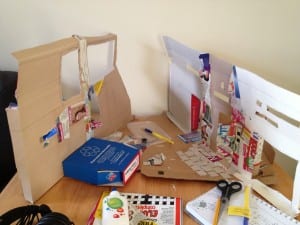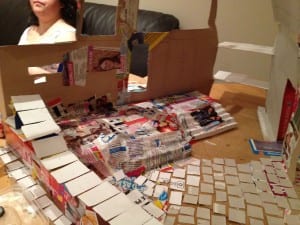During my first look at The Collection Gallery I was more intrigued by the architecture of the building than the works contained within it. I liked the idea of using the building to formulate a piece from just looking at the way in which the building was held together. I want to look more into the way that the architecture affects the uses of the building and how the public view the collection gallery as it stands next to the less modern usher gallery. Does it look out of place? An eyesore? Or is it a beauty in its own right?
To document my appreciation of the architecture of the gallery I have started to recreate the collection gallery building using cardboard, this allows me to look into the detail of the gallery a lot further in my attempt to recreate it. This will also help with our future ideas as we can use it to build models of our set therefore trying our ideas out before we set off to do it on a much larger scale.
‘Barbara Kirschenblatt-Gimblett makes an even more explicit comparison: ‘exhibitions are fundamentally theatrical, for they are how museums perform the knowledge to create’ (Destination Culture, 1998, p. 3). Traditionally, of course, museums arranged their collections in predictable, linear narratives, committed to organizational categories intended to be definitive’ (Bennett, 2013, pg 4) This quote from Theatre and Museums shows how museums can be seen as theatre as well as exhibits. I agree with this, that an art gallery is theatrical in concept. Performer’s present work, a gallery does exactly the same. I like the idea of a gallery being theatre, I believe it give the visitors a chance to become an audience and view the piece and infer it’s meaning. Art is open to interpretation similar to many Site-Specific performances, this itself is an interesting observation and this has now given me a new view of the gallery and I now feel that I will look at the exhibitions differently upon my next visit to the gallery.
I was particularly interested with the cafe, the architecture within it is beautiful with lots of different layers and levels using different materials to contrast and complement one another. I would like to base a performance in this area as it has natural frames to the place. The windows in the cafe are like big frames to the outside world connecting the frames of the gallery artwork to the space in the cafe. There is one big window that points up towards the cathedral and frames it up on steep hill. I think using the architecture to frame the piece would be a nice way to get the beauty of the building in with the idea of Site-Specific performance.
Bennett, Susan (2013) Theatre and Museums, Basingstoke: Palgrave Macmillan




